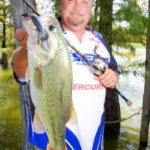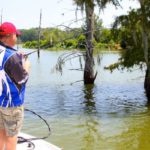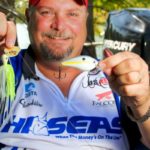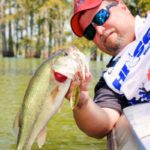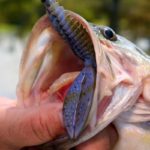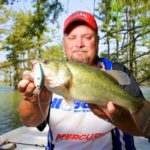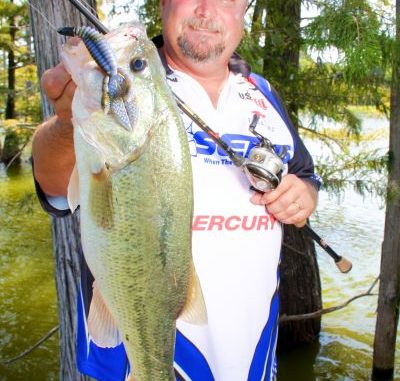
Anglers aren’t the only creatures looking for shade when the sun blasts down. Here are some tips on how to leverage that knowledge to catch stringers of bass.
My Lucky Craft Sammy topwater landed less than its length from the base of a cypress tree. I mindlessly snapped it back and forth a couple times to impart that lazy walk-the-dog action that big bass just can’t seem to ignore.
At 7:30 in the morning, my shirt was already soaked with sweat, so I diverted my attention away from my Sammy sitting lifelessly on the surface in an effort to see if there was any shade we could get under.
The slurping sound hardly registered in my mind, so when I turned around to walk my Sammy again, I was surprised to find that it was nowhere to be found.
“You going to catch that fish or not?” my fishing partner for the day, Porter Trimble, asked.
The bass that I didn’t even know was on the end of my line had apparently sucked down my topwater and just sat there. My line wasn’t even taut, but when I pulled my rod up to see if Trimble was pulling my leg, the water suddenly erupted.
After admiring the fish and enduring Trimble busting my chops, I slid the bass back in the water and watched him lazily swim back to the cypress tree.
I tried to pass off an excuse for why I didn’t know the bass had slurped down my Sammy.
“I was looking for some shade for us to fish under,” I told Trimble.
“It’s too early for us to get in the shade,” he responded, “but we might want to start making sure our baits land in some. Didn’t you notice your Sammy landed on the shady side of that tree?”
How could I with all the sweat stinging my eyes?
But so goes summertime fishing anywhere in Louisiana.
Trimble and I just happened to be fishing a small nondescript lake near the Saline/Larto complex that the guides at Honey Brake Lodge sometimes fish.
It could have been “Any Lake Louisiana.” Its shoreline was lined with grass. A few trees had toppled over into the water’s edge. And the middle of the lake was thick with cypress trees.
With a flooded channel running through the trees, it struck me how this small lake — which was not much more than a flooded cypress brake — was a scale model of larger lakes like D’Arbonne, Bistineau and Caddo.
Trimble and I had planned on fishing the standard summertime pattern of beating the banks early with topwater baits, switching to spinnerbaits a little bit later and backing off to the trees as the sun got up.
The weak link in that chain was the early-morning topwater bite. For whatever reason (I imagine the oppressive heat had something to do with it), the bass missed that part entirely and —except for our lone topwater bite — went straight to the spinnerbait.
“Just about anywhere you go in Louisiana, it’s going to be this way in September,” Trimble explained. “It’s a kind of weird transition month because they’re not quite in their fall pattern yet because the water temperature is so hot, but they start moving toward it even though the water temperature is so hot.”
One thing Trimble has noticed over years of fishing bass tournaments and filming television shows is that summertime bass like to seek some September shade whenever and wherever it’s available.
“You’ll see them pushing baitfish up shallow first thing in the morning,” he pointed out, “but then they almost immediately start looking for that shade and the cooler water temperature that comes with it.”
After speculating that the bright moon the night before had something to do with our lackluster topwater bite, Trimble decided that it was time to stop being hardheaded about forcing that bite.
He noticed some shad flicking around on the bank that was, as of yet, unsullied by the morning sun, so we picked up some chartreuse-and-white Strike King Premiere spinnerbaits and started slinging them toward the shoreline.
Three or four fish later, Trimble was confident we had made the right decision. He had discovered that bass were hanging out right on the edges of the shoreline vegetation.
And even when we fished a bank that was already being blistered by the sun, we could still get bit on our spinnerbaits by working them through shady zones.
“Shade doesn’t always have to be a cypress tree or a boat dock,” Trimble explained as he released yet another bass. “Anything that casts a shadow could hold a fish or two this time of year, although I believe it has more to do with food and comfort more than the sunlight hurting their eyes.”
Probably, bass seeking out shady spots during the summer has more to do with the comfort factor above everything else. When the water temperature is reading 90 degrees, they’re going to move to that little bit cooler water in the shade, even if there is only a degree or two difference.
Although we had planned on sticking with the spinnerbaits until 10 or so, the bite didn’t last that long. As we got to a spot where the cypress trees were close enough for me to pitch to them out of the other side as Trimble worked the bank, I had to put down my spinnerbait rod and pick up the flipping stick.
My eyesight isn’t what it used to be, so I had spooled my Abu Garcia Revo STX with 20-pound-test fluorescent yellow Berkley ProSpeck premium monofilament the night before.
I easily watched it jump and move off the tree on my first cast. A bass had grabbed my Bama Bug-colored Berkley Havoc Hawk Hawg just as it slid down the shady side of a cypress tree.
“Well now you’ve ruined me,” Trimble declared. “I usually don’t move off to the trees until the sun gets really high. Seems to me the higher the sun the better they get on the trees, but I guess I’ve got to pick up my flipping rod now.
“Can’t let you whip me with my favorite way to fish while I’m throwing a blade.”
Over the next two hours, Trimble and I weaved in and out of the cypress tree thicket with our flipping sticks in hand. The only difference was that I was fishing the Hawk Hawg and he was fishing the Strike King Rodent.
There was no rhyme or reason to which trees the fish were on, but there was a common denominator for every bite we got.
Shade.
“Usually you can pattern flipping fish on certain kinds of trees,” Trimble explained. “Sometimes it’s those with big root systems. Sometimes it’s the clusters of trees. But today we’re catching them off a little bit of everything — even dead trees.”
As we pressed on, Trimble noticed that all our bass were coming in clusters. Whenever and wherever one of us got bit, the other soon followed up with a second fish.
That was when Trimble realized that most of our bites were coming along the edge of a very subtle channel that swung through the trees.
“I bet what’s happening is that bass are not only in the shade, but they’re in the deepest shady spots,” he surmised. “You know sometimes when you go swimming in a lake and your feet hit those little cool pockets of water? I think that’s what’s happening here.”
Since we had the fish pegged as to where they were holding, Trimble decided to try a couple other presentations just to experiment.
Besides topwaters, spinnerbaits and soft plastics, he is a big fan of square-billed crankbaits and chatter-style baits around shady cypress trees.
“I’ve been a big fan of square bills for years,” he noted as he tied on a Strike King KVD 2.5 crankbait. “They’re designed to hit the roots and bounce off to get a reaction bite.
“And even though I’ve got a lot of confidence in pitching, I can cover a lot more water with a crankbait.”
He began banging his crankbait around the trees, but I noticed that he also didn’t give up on a cast as easily as he might have with the soft plastic, which he got in and got out quickly if a fish didn’t bite.
Rather, Trimble worked the crankbait on the shady side of the tree and kept working it for the entire length of the shade created by the tree’s trunk or canopy.
“Sometimes they’ll eat it right on the tree, but other times they’ll bite 5 or 6 feet away from it,” he said. “I can’t tell you if a fish I catch away from a tree was just staged up out there or if it followed my crankbait off the tree.
“My thinking is that they probably follow it off the tree and it just happened to wiggle the right way to trigger a strike. They do the same thing with the plastics sometimes.”
We wound up leaving the bass biting as we wrapped up our trip by 11 because the stifling heat became too much to take. We wanted something a little cooler than a shade tree, and our truck air conditioners came to mind.
But before loading his boat back on the trailer, Trimble and I landed and released over 20 bass on a hot, sweltering summer morning by realizing that we weren’t the only creatures that would rather have it made in the shade than being hot and bothered.
